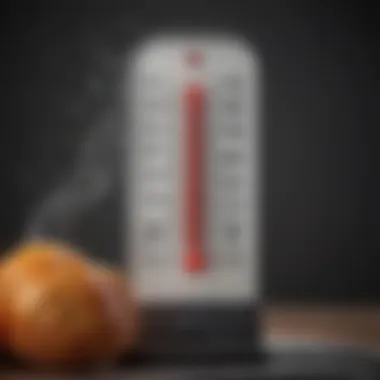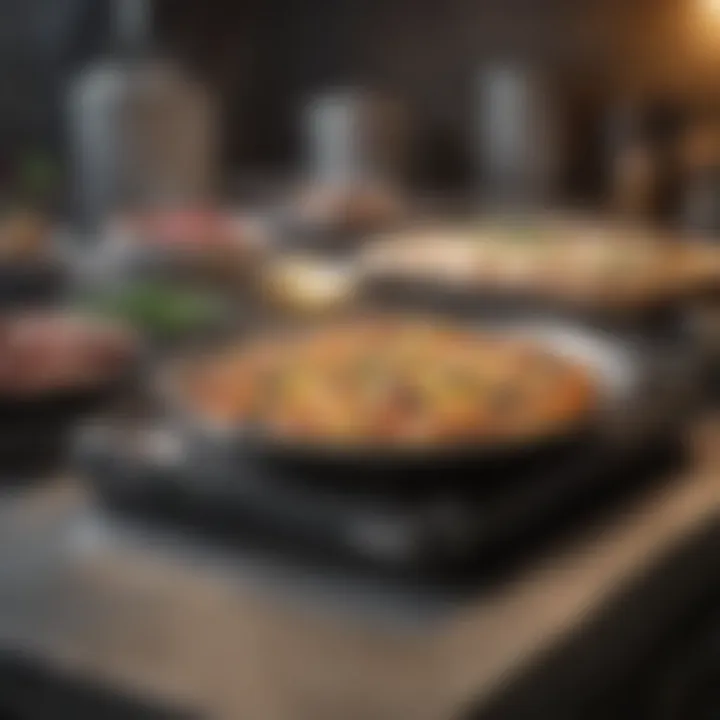Understanding Safe Food Temperatures for Health


Intro
The temperature at which food is cooked or stored can significantly affect its safety. Different types of food have distinct thresholds at which harmful bacteria can grow or die. This article aims to shed light on these critical temperature points, the importance of using food thermometers, and practical advice for achieving safe cooking practices at home.
Health authorities around the globe have provided guidelines to steer us in the right direction. Ignoring these guidelines can lead to serious health risks. Therefore, it is crucial to familiarize oneself with safe food handling practices. Each section of this article will contribute to a cohesive understanding of food safety by analyzing key aspects in detail.
Through this exploration, we aim to equip readers with the knowledge necessary to ensure that their culinary endeavors not only satisfy taste buds but also safeguard health. With accurate temperature management, every meal can be both delightful and secure.
Foreword to Food Safety
Food safety is a fundamental concern in culinary practices, pivotal to protecting public health. The topic of safe food temperatures is especially crucial, as it serves as a cornerstone for preventing foodborne illnesses. By understanding the principles of food safety, individuals can equip themselves with knowledge that ensures their meals are not only appetizing but also safe to consume.
Maintaining proper food temperatures means controlling the environment in which food is prepared, cooked, and stored. This control encompasses understanding both cooking temperatures and storage practices. Adhering to guidelines can significantly reduce risks associated with harmful bacteria and pathogens. Proactive management of these temperatures leads to safe food practices, fostering healthier communities.
Importance of Safe Food Temperatures
Safe food temperatures help minimize the possibility of foodborne illnesses, which can pose dire threats to health. Cooking foods to the appropriate internal temperature destroys harmful microorganisms that can lead to sickness. For instance, chicken should reach an internal temperature of 165°F (74°C) to ensure safety.
Furthermore, maintaining the right temperature during storage is equally important. Refrigerators should be kept below 40°F (4°C) to slow bacterial growth, while freezers need to be at 0°F (-18°C) or below to effectively halt it. These guidelines provide a framework to prevent the conditions that lead to food spoilage and contamination.
Foodborne Illnesses: A Global Concern
Foodborne illnesses are a pressing global issue, affecting millions annually. According to the World Health Organization, unsafe food causes 600 million illnesses worldwide each year, resulting in 420,000 deaths. Vulnerable populations, such as young children, elderly individuals, and those with weakened immune systems, are particularly susceptible to severe effects of these illnesses.
The impact of foodborne pathogens extends beyond individual health, imposing substantial economic burdens on healthcare systems. Costs associated with treatment and lost productivity illustrate why effective food safety measures are essential. Educating consumers about safe food handling and the importance of proper food temperatures is a vital part of addressing this public health challenge. By fostering an informed public, the prevalence and severity of these illnesses can be diminished, leading to safer food practices globally.
The Science of Temperature and Food Safety
Understanding the science of temperature in the context of food safety is essential. Temperature directly influences the growth and survival of bacteria, which can lead to foodborne illnesses if not managed properly. Each food has a different tolerance level for temperature fluctuations, and knowing these specifics can significantly reduce the risks associated with improper food handling.
The main benefit of understanding food temperatures lies in its ability to protect public health. Foodborne pathogens thrive in certain temperature ranges, making it crucial for food handlers to be informed about these thresholds. The health consequences of negligence can be severe, leading to illness and even hospitalization. By utilizing established guidelines, food safety can be enhanced significantly.
Moreover, food safety education is a critical consideration in this discussion. Home cooks and professional chefs alike must be aware of the principles governing temperature control. Failure to understand these principles can lead to dangerous practices, which can be avoided through proper knowledge. The repercussions of disregarding food temperature guidelines extend beyond individual health, affecting broader public health outcomes.
How Temperature Affects Bacteria Growth
Bacteria, the primary culprits behind foodborne illnesses, have specific temperature ranges in which they grow best. The temperature at which bacteria proliferate is typically between 40°F (4°C) and 140°F (60°C). This range is known as the "Temperature Danger Zone." In this zone, bacteria can double in number within as little as 20 minutes.
Different types of food can support bacterial growth to varying degrees. For example, protein-rich foods like meat and dairy are particularly susceptible to bacterial contamination. To mitigate this risk, it is critical to cook food at prescribed temperatures and store it within safe zones.
Maintaining proper cooking and storage temperatures is not merely a guideline but a necessity for safeguarding human health. It is important to recognize that some bacteria can produce toxins that remain harmful even after the bacteria have been killed.
The Temperature Danger Zone
The Temperature Danger Zone is a critical concept in food safety. It is defined as the range between 40°F (4°C) and 140°F (60°C), where bacteria can thrive and multiply. Food left in this temperature range for too long can become unsafe to eat. It is imperative to minimize the time that food spends in this zone.
When preparing food, vigilance in monitoring temperatures will prevent items from entering this danger zone for extended periods. To aid this, the following practices are crucial:
- Keep hot foods hot: Keep foods cooking at temperatures above 140°F (60°C). This is essential for both safety and quality.
- Chill cold foods cold: Foods should be stored at temperatures below 40°F (4°C). This practice slows down bacterial growth effectively.
- Cook food to safe temperatures: Each type of food has a required internal temperature, which helps eliminate harmful bacteria.
Understanding and respecting the temperature danger zone can significantly reduce the risk of foodborne illnesses. Individuals involved in food preparation must remain aware of this concept to ensure safe culinary practices.


"Food safety is not just a responsibility; it is an obligation to ourselves and others. Keeping food out of the Temperature Danger Zone can help ensure safe consumption."
Safe Cooking Temperatures for Various Foods
Understanding safe cooking temperatures is crucial in the culinary world. Cooked food must be heated to specific internal temperatures to effectively kill harmful bacteria. This article underscores the significance of adhering to these temperature guidelines. By knowing these benchmarks, not only do cooks ensure food safety, but they also enhance the overall quality and flavor of their dishes. Safe cooking is not just about avoiding illness; it is about serving flavors in their best possible form.
Poultry: Ensuring Thorough Cooking
Poultry, including chicken and turkey, requires careful attention to cooking temperatures. The recommended internal temperature for all poultry products, including whole birds and ground poultry, is 165°F (74°C). Reaching this temperature is vital as it helps in eliminating pathogens such as Salmonella and Campylobacter, which are prevalent in poultry.
It's important to use a food thermometer inserted into the thickest part of the meat, away from bones, for accurate readings. The thermometer should not touch the pan or surface for the most precise temperature measurement. Once the poultry reaches 165°F, allow it to rest for several minutes. This rest period allows the juices to redistribute, ensuring a moist and flavorful result.
Red Meat and Seafood Guidelines
Red meat, which includes beef, lamb, and pork, has specific temperature guidelines that vary depending on the cut and preparation.
For ground beef, the safe internal temperature is 160°F (71°C), while steaks and roasts can be safely cooked to 145°F (63°C) with a three-minute resting time before carving or consuming. Using a thermometer is highly recommended to avoid undercooking.
Seafood, including fish and shellfish, must also be handled with care. The general safe cooking temperature for fish is 145°F (63°C). Cook fish until it is opaque and separates easily with a fork. With shellfish, such as shrimp and lobster, it should be cooked until the flesh is pearly and opaque. For clams, mussels, and oysters, they need to open during cooking; any that do not should be discarded.
Eggs and Dairy Products
Eggs should be cooked until both the whites and yolks are firm to ensure safety. The safe internal temperature for dishes containing eggs is 160°F (71°C). Dishes like quiches or casseroles must also reach this temperature to eliminate any potential risk of Salmonella.
For dairy products such as cheese and milk, it is best to keep them refrigerated unless cooking. When cooking with dairy, ensure sauces or custards are heated enough to be safe but do not exceed temperatures that could curdle the product.
In summary, knowing and applying the proper cooking temperatures for poultry, red meat, seafood, eggs, and dairy helps in creating safe and appealing dishes. This knowledge not only protects against foodborne illnesses but also enhances the culinary experience. Educational resources on safe cooking temperatures can be found on platforms like Wikipedia and Britannica.
Remember, accurate temperature control is the cornerstone of safe cooking.
Utilizing Food Thermometers Effectively
Using food thermometers is a fundamental practice in ensuring food safety within the kitchen. These instruments help to ascertain whether food has reached a safe temperature, effectively minimizing the risk of serving undercooked meals that may harbor harmful bacteria. Understanding how to utilize these devices properly is crucial for home cooks and professionals alike.
Efficient use of food thermometers enhances not only the safety of the food but also its flavor and texture. For example, overcooking meat can lead to a dry and unappetizing meal. On the other hand, using the thermometer correctly guarantees that meat is cooked to the appropriate internal temperature, preserving juiciness.
Benefits of Using Food Thermometers:
- Accuracy: Taking the guesswork out of cooking, ensuring food reaches optimal doneness.
- Food Safety: Reducing the risk of foodborne illnesses by ensuring proper cooking temperatures.
- Flavor Optimization: Achieving perfect doneness leads to better flavor and texture in prepared meals.
In a world where food safety is paramount, integrating food thermometers into cooking practices is not merely recommended but essential.
Types of Food Thermometers
There are various types of food thermometers, each with its unique features and functionalities. The most common types include:
- Digital Instant-Read Thermometers: These provide a quick readout of the temperature, ideal for checking doneness in meats and baked goods.
- Dial/Analog Thermometers: Slower to respond but useful for checking temperatures in larger cuts of meat or deep-fried foods.
- Probe Thermometers: Can stay in the food while it cooks, providing continuous temperature readings and alerts when the desired temperature is reached.
- Infrared Thermometers: These measure the surface temperature of food without direct contact, beneficial for checking hot foods or large trays of food where inserting a probe would be impractical.
Each type has its advantages depending on the cooking method and the food item in question, emphasizing the need for choosing the right thermometer for your cooking tasks.
How to Properly Use a Food Thermometer


Proper usage of a food thermometer is critical to obtaining accurate readings. Here are the essential steps to follow:
- Calibrate Regularly: Check the thermometer’s accuracy by placing it in boiling water; it should read 212°F (100°C). Make adjustments as needed.
- Insert Correctly: For meats, insert the probe into the thickest part of the food, avoiding bones and fat. This ensures the most accurate temperature reading.
- Wait for the Reading: Allow the thermometer to stabilize before reading, particularly for instant-read models. This may take a few seconds.
- Clean After Use: Sanitize the thermometer after each use to prevent cross-contamination.
Using a food thermometer properly is not just about taking a temperature; it’s about understanding the principles behind safe cooking practices. Following these steps will enhance your culinary skills while maintaining a focus on food safety, ultimately contributing to a well-prepared meal that is both safe and delightful.
"Using a food thermometer can change your culinary game. It's about safety and deliciousness together."
In summary, understanding and utilizing food thermometers is an indispensable element of safe food preparation. By recognizing the types available and mastering effective usage techniques, cooks can significantly enhance the safety and quality of their dishes.
Storing Food at Safe Temperatures
Properly storing food at safe temperatures is a critical aspect of food safety that cannot be overlooked. It prevents the growth of harmful bacteria and ensures that food retains its quality and freshness. Maintaining the right temperature helps to preserve nutrients and prevent spoilage, thus minimizing food waste. Beyond the practicality of extending the shelf life of products, it also plays a significant role in reducing the risk of foodborne illnesses. Remember, the key to food safety in storage is understanding the specific temperature requirements for both refrigeration and freezing.
Refrigeration: The Cold Facts
Refrigeration keeps food cold, slowing down bacteria growth and prolonging food quality. The recommended refrigerator temperature is below 40°F (4°C). Anything above this threshold invites bacteria to thrive, increasing the risk of illness. It is advisable to regularly check the temperature using a thermometer to ensure it remains consistent.
When storing food, the following tips can help maintain safety:
- Organize foods: Place raw meats on the bottom shelf. This prevents any drips from contaminating other foods.
- Use airtight containers: They not only keep food fresh but also limit cross-contamination.
- Label and date items: This helps in managing older products and ensures nothing is left too long in the fridge.
It’s important to be mindful of how long certain items can stay in the refrigerator. For example, cooked leftovers should ideally be consumed within three to four days to reduce risk.
"Storing food properly can save both your health and your money."
Freezing and Thawing Guidelines
Freezing is an effective way to preserve food for extended periods. Foods kept at 0°F (-18°C) or lower remain safe indefinitely, though quality may diminish over time. However, freezing does not kill bacteria; it only halts their growth. Therefore, it’s essential to freeze food that is fresh and in good condition.
When freezing:
- Cool foods before freezing: Hot foods can raise the temperature of your freezer, putting other items at risk.
- Label your items: Not just the names, but also the dates to ensure you are using food within the safe time limits.
- Avoid overloading the freezer: This helps maintain a consistent temperature throughout.
Thawing food must also be done safely, to prevent bacteria from multiplying. Options include:
- Refrigerator thawing: This is the safest method. It can take time but keeps food at safe temperatures.
- Cold water thawing: Submerging sealed food in cold water speeds up the process but requires frequent water changes.
- Microwave thawing: Be sure to cook the food immediately after thawing, as some areas may begin to warm and foster bacteria growth.
Understanding these principles can help ensure food safety when dealing with storage, thereby enhancing the overall quality of meals and well-being.
Best Practices for Kitchen Safety
Maintaining safety in the kitchen is fundamental for both food quality and health. There are several best practices that home cooks should be aware of to minimize the risk of foodborne illnesses. Emphasizing these practices not only prevents contamination but also promotes a healthier cooking environment. From proper cleaning techniques to preventing cross-contamination, each element plays a vital role in ensuring a safe culinary experience.
Cleaning and Sanitization
Cleaning and sanitizing are two crucial steps in food safety. Cleaning involves removing dirt, food residues, and spills from surfaces. Sanitization, on the other hand, reduces harmful pathogens to safe levels. This is especially important in areas where food is prepared or consumed.
Here are some key points regarding cleaning and sanitization:
- Use appropriate cleaning agents: Select cleaners that are safe for food contact surfaces. Avoid using harsh chemicals that can leave harmful residues.
- Regular cleaning schedule: Make it a habit to clean surfaces like countertops, cutting boards, and utensils after each use. Implement a weekly deep cleaning routine for appliances and storage areas.
- Washing hands: Always wash your hands thoroughly with soap and warm water before and after handling food. This simple act is one of the most effective ways to prevent the spread of bacteria.


"Proper cleaning and sanitization practices are essential in preventing cross-contamination and ensuring food safety."
Cross-Contamination Prevention
Cross-contamination occurs when harmful bacteria or allergens are transferred from one food item to another, often through surfaces or equipment. Preventing cross-contamination is critical for safe food handling. Here are some strategies:
- Separate raw and cooked foods: Use different cutting boards and utensils for raw meat, poultry, seafood, and ready-to-eat items. This helps prevent the transfer of harmful pathogens.
- Store food properly: Keep raw foods on the bottom shelves of the refrigerator. This avoids drips onto other foods. Store cooked items above raw items.
- Use protective gear: Wear gloves when handling raw foods. If using your hands, wash them before switching to a different type of food.
By implementing these practices, kitchens can significantly reduce the risk of foodborne illnesses. Food lovers must understand that safety does not only lie in cooking temperatures but in every aspect of the food preparation process.
Common Myths About Food Temperature
Understanding common myths about food temperature is crucial for ensuring food safety. Many individuals hold misconceptions that can lead to unsafe practices in the kitchen. These myths often arise from outdated information or semi-accurate interpretations shared broadly through cultural narratives or television programming. Dissecting these myths helps home cooks and food enthusiasts alike create safer culinary environments. Ultimately, by addressing these misconceptions, we enhance our overall understanding of food safety, which is essential for preventing foodborne illnesses.
Myth Busting: Temperature Misconceptions
One prevalent misconception in the culinary world is that food can be safely left at room temperature for a couple of hours without risk. The reality is rather alarming. According to the United States Department of Agriculture (USDA), perishable food should not be left out for more than two hours. In warmer conditions, above 90°F, this period shortens to just one hour. When food sits in the temperature danger zone between 40°F and 140°F, harmful bacteria can thrive, multiplying rapidly and increasing health risks.
Another common belief is that meat is safe to eat as long as it looks cooked. What many overlook is the importance of internal temperature. Visual cues alone cannot guarantee the eradication of dangerous bacteria such as Salmonella or E. coli. For instance, poultry needs to reach an internal temperature of 165°F for safe consumption, irrespective of its outer appearance. Using a food thermometer is crucial to accurately assess temperatures and ensure complete cooking.
"Understanding and dispelling myths about food temperature can drastically reduce foodborne illnesses in our communities."
Lastly, there is the myth that microwaving food guarantees thorough cooking. While microwaves are convenient, uneven heating can leave cold spots, where bacteria can survive. To ensure even cooking, it's advisable to stir food and allow it to stand for a few minutes after microwaving. This not only helps distribute heat but also allows time for the residual heat to eliminate any harmful pathogens.
Understanding Cooking Shows and Recipes
Cooking shows and widely circulated recipes can sometimes perpetuate these myths about food temperature. Professionals often showcase cooking techniques that prioritize visual appeal over food safety, leading novice cooks to trust the process without question. Many viewers might notice a chef searing meat in a hot pan, then immediately serving it, thinking it is properly cooked. In reality, even chefs must monitor food temperature carefully.
Additionally, some recipes may not provide adequate guidance on minimum cooking temperatures. Without proper specifications, home cooks may unintentionally serve undercooked dishes. Therefore, it is vital for culinary content creators to include recommended temperatures in their recipes and to educate viewers on best practices. Ensuring that this information is accessible and clear can foster better understanding among audiences about food safety.
Ultimately, fostering a culture that prioritizes safe cooking practices not only enhances individual experiences in the kitchen but also contributes to the wider community's health.
Final Thoughts on Safe Food Temperature Practices
Food safety is not only a matter of avoiding illness but also enhancing the overall culinary experience. Cooking foods to the correct internal temperatures ensures that they not only taste good but also provide safety from harmful bacteria. With the ongoing rise of food allergies and sensitivities, safe temperature practices serve as a foundation to protect vulnerable populations.
The efficacy of educational initiatives in food safety cannot be overlooked. When consumers are well-informed about food temperatures, they are empowered to make safer choices in both home cooking and dining out. This education can come from various channels, such as cooking classes, community workshops, and reputable online resources.
"Education is the first line of defense against foodborne illness.”
Adhering to safe food temperature practices also promotes professionalism in culinary settings. Establishing a culture that prioritizes safety enhances the reputation of kitchens and fosters customer trust. It can result in increased patronage as diners feel assured that their health is being considered.
The Role of Education in Food Safety
Various platforms can be utilized to disseminate this knowledge, making it accessible to a broader audience. Schools, culinary institutes, and online platforms can offer courses that emphasize the critical components of food safety, including temperature management.
Moreover, public health organizations often run campaigns to educate consumers about food safety through workshops and informative materials. Utilizing these resources can greatly reduce the risk of foodborne diseases in communities.
Encouraging a Culture of Safety in Culinary Practices
Fostering a culture of safety in culinary practices is essential for both commercial and home environments. By consistently prioritizing food safety, individuals and businesses can create an atmosphere where safety is paramount.
Some strategies to encourage this culture include:
- Continuous training and updates on food safety practices for staff.
- Implementing standard operating procedures that prioritize temperature checks.
- Using clear signage within kitchens that display safe temperature guidelines.
- Engaging staff in discussions about the importance of food temperature management to foster a sense of ownership.
In home settings, creating habits of checking temperatures can make a substantial difference. Simple practices like using a food thermometer and being mindful of recommended cooking temperatures can enhance safety in daily cooking.
Ultimately, a culture of safety leads to better food handling practices, increased consumer confidence, and overall improved health outcomes in communities.







